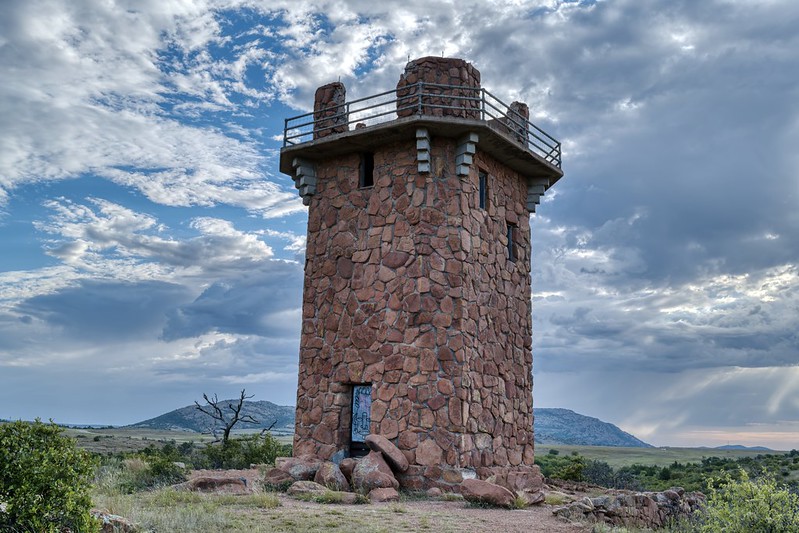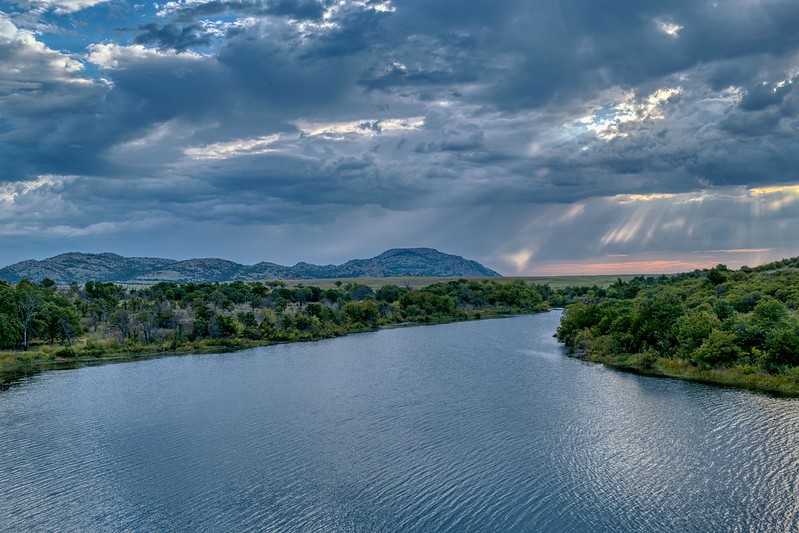I spent an early morning at Lake Jed Johnson Oklahoma, chasing the kind of light that only happens when weather systems collide with the granite landscape. The Wichita Mountains delivered exactly what I was hoping for: dramatic skies, historic architecture, and that raw, untamed feeling that makes this place worth the drive.
The Jed Johnson Tower

My first photo of the day was the historic Jed Johnson Tower, a stone observation structure built by the Civilian Conservation Corps in the 1930s. The tower sits on a ridge overlooking Lake Jed Johnson and the surrounding mountains. I got there just as morning light began breaking through the cloud cover, creating bright patches against darker storm clouds.
The stonework on this tower is impressive. CCC crews used local granite, and the irregular shapes give it a rugged, handcrafted look that fits perfectly with the landscape. The observation deck at the top has a metal railing that catches the light, and a narrow window opening at the base adds visual interest to the composition.
Camera: Fujifilm X100VI
Settings: 23mm, f/8, 1/250 sec, ISO 250, EV 0
I shot at f/8 to keep both the tower and background mountains sharp. The 1/250 second shutter speed froze cloud movement and kept the image crisp. ISO 250 gave me a clean file with no noise issues.
Lake Jed Johnson Under Storm Light

The second image came from the same morning, but the weather had shifted. A storm system was moving through, and the sun found a gap in the clouds long enough to send down those god rays that landscape photographers dream about. The light hit the distant mountains and illuminated parts of Lake Jed Johnson while leaving other areas in shadow.
The lake stretches below the tower, surrounded by dense vegetation and backed by the granite hills that define this refuge. The mix of dark storm clouds, bright shafts of sunlight, and calm water made a dramatic scene.
Camera: Fujifilm X100VI
Settings: 23mm, f/8, 1/200 sec, ISO 250, EV 0
The settings here were nearly identical. I slowed the shutter slightly to 1/200 second to let in more light since the storm dimmed the scene. The f/8 aperture kept everything from foreground to distant hills in focus.
Wildlife Notes
The Wichita Mountains Wildlife Refuge supports healthy populations of American bison, Rocky Mountain elk, white-tailed deer, prairie dogs, and wild turkeys. I didn’t photograph wildlife during this session since I was focused on the landscape, but the refuge is one of the best places in Oklahoma to see these animals in a natural setting.
Established in 1901, it was among the first U.S. wildlife preserves. It played a key role in saving the American bison from extinction. The refuge received 15 bison from the New York Zoological Park in 1907, and that herd has since grown to about 650 animals.
Elk were reintroduced in 1911–12 from Jackson Hole, Wyoming, after the native population disappeared. Today, around 400–600 elk live here. Texas longhorn cattle were added in 1927 to preserve that historic breed.
For wildlife photography, early morning and late afternoon are best. Bison and elk are most active then and often near the open roads. Prairie dog towns are scattered throughout the refuge and active during daylight hours.
Photography Notes
The Fujifilm X100VI handled this morning session easily. Its 23mm fixed lens (35mm equivalent) is wide enough for landscapes while still giving some reach for architectural detail. The f/8 aperture gave me the depth of field I wanted in both shots.
The weather changed fast. I started with partly cloudy skies and within 30 minutes faced a full storm system. A weather-sealed camera helps, but the key is being ready to adjust exposure quickly. I shot in aperture priority mode so I could lock in f/8 and let the camera manage shutter speed as the light changed.
The dramatic sky made these photos work. Flat, blue skies would have been dull. When you’re shooting landscapes, weather is your friend. Clouds add texture, storms add drama, and that brief moment of sunlight can turn an ordinary scene into a keeper.
For the tower photo, I positioned myself to frame it against the sky with mountains as background context. For the lake shot, the water serves as a leading line guiding the eye toward the distant ridges.
I shot both images in RAW, which gave me flexibility in post-processing to balance contrast and exposure. The X100VI’s dynamic range made it easy to pull detail from shadows without noise.
Getting There
The Wichita Mountains Wildlife Refuge sits about 25 miles northwest of Lawton and 90 miles southwest of Oklahoma City. The headquarters is on State Highway 115, and from there you can access the main scenic drive that loops through the refuge.
Jed Johnson Tower is along the main refuge road system. There’s a small parking area near the ridge base, and from there it’s a short, rocky hike up. Wear good footwear, the trail is uneven.
Lake Jed Johnson Oklahoma is visible from several roadside pullouts. I photographed mine from one that overlooks the lake directly. Other lakes in the refuge, like Elmer Thomas and Quanah Parker, also offer great photo opportunities.
The refuge is open year-round during daylight hours, with no entrance fee. The visitor center provides maps, trail info, and current wildlife updates.
Related: Jed Johnson Tower

WOW!!!!! Gorgeous pics, beautiful area. 💜💜💜
Excellent!
Great story and photos. Isn’t that a beautiful place! The CCC did some remarkable stonework construction all over our part of the country, but I had never seen anything like that tower.
Thanks so much.